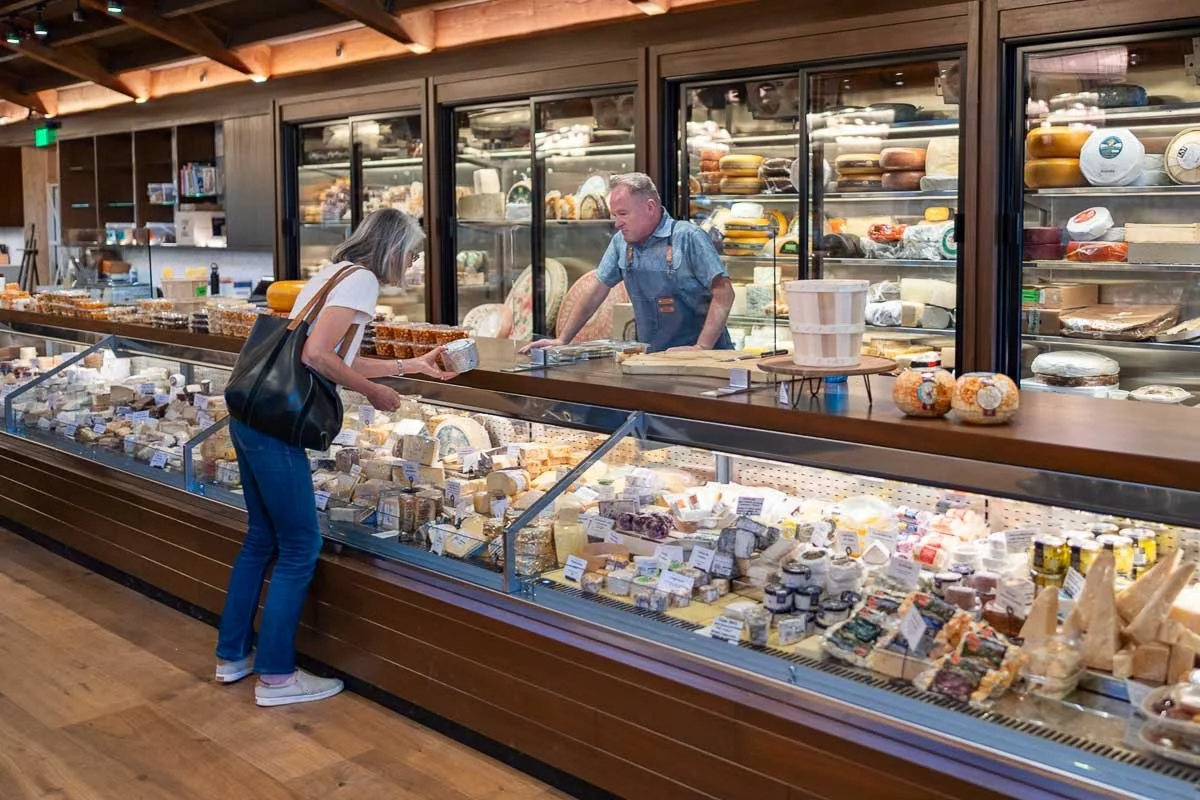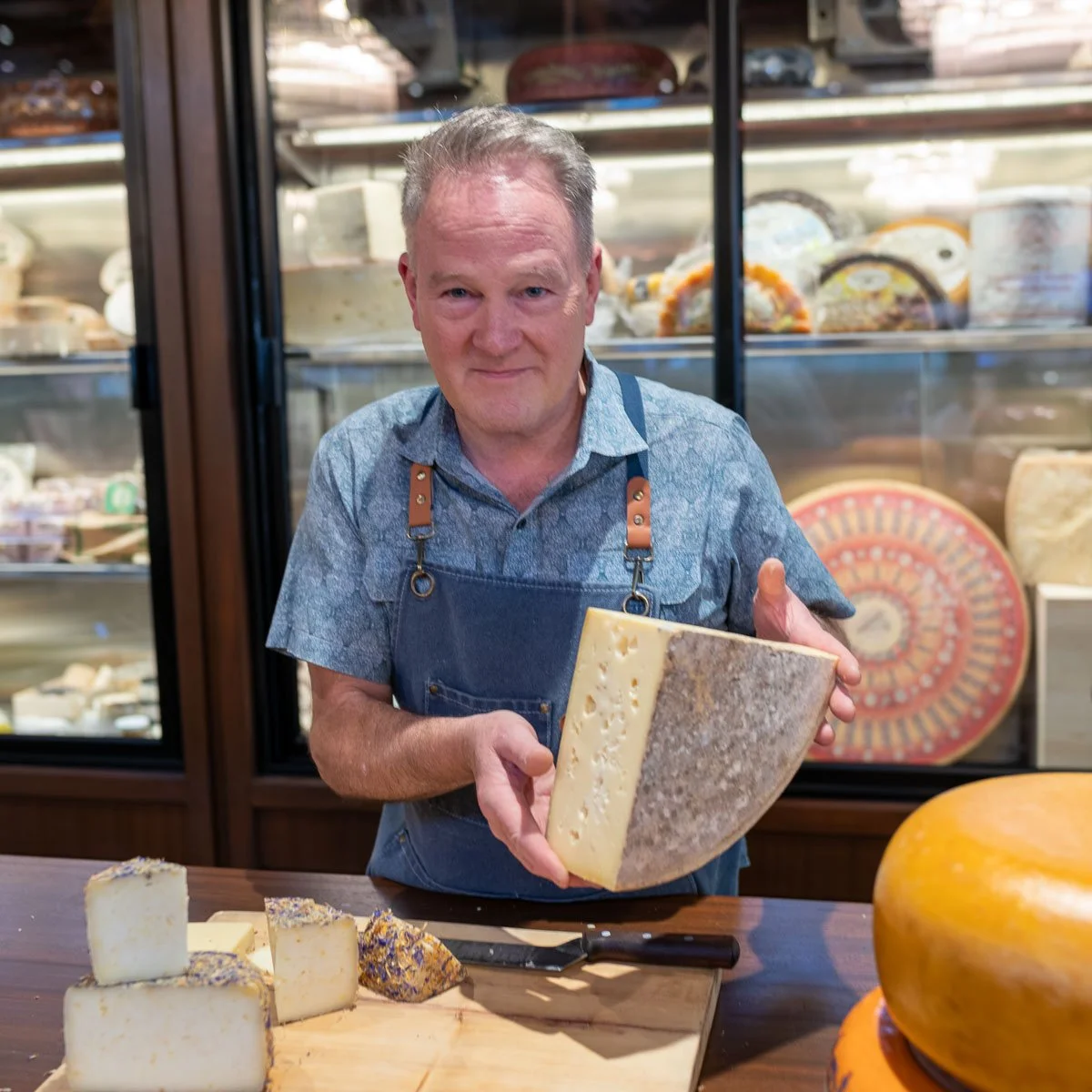Napa Valley’s V. Sattui Winery has long boasted a substantial cheese counter. Yet, despite living nearby, I almost never shopped there. Driving past it, I channeled Yogi Berra. (“Nobody goes there anymore. It’s too crowded.”) Sattui’s St. Helena tasting room is one of the most visited in the valley, its parking lot perpetually filled with tour buses and its grounds thronged with picnickers. Navigating that scene for a pound of cheese was something I rarely had the patience for. But boy, have I had an attitude adjustment. After an extensive remodel, the tasting room looks like a Ralph Lauren store and the vast cheese counter—now in the hands of one of the nation’s most experienced mongers—repays braving the hordes.
Master monger: James Ayers
Hiring James Ayers to run this counter was management’s smartest move. Ayers has been selling cheese in California wine country for almost 30 years. He’s a risk taker and a genuine enthusiast with a deep appreciation for the good stuff. He understands that the picnickers want their Fromager d’Affinois—a double-cream Brie that every supermarket stocks—but he also believes he can lead them to higher ground, to the more artisanal Jean Grogne or Gratte Paille.
Ayers has 26 linear feet of refrigerated cases to fill—an enormity—and I was a little surprised when he told me he did so with no plan. Analytical me. I assumed you would make a spreadsheet with slots for cheese of every conceivable type, from French goat blue to English farmhouse Cheddar to mozzarella di bufala. But Ayers buys what he loves and if it’s new and he has to hand-sell it, so much the better.
“I don’t believe in passive sampling,” he says, referring to the practice of putting out help-yourself nibbles. “I’d rather talk about it and educate.” The first weekend in the new shop he sold almost 10 pounds of Bergkase, a little-known Italian alpine wheel that few shoppers would choose without prompting.
I noted a predominance of Italian cheeses—a nod to the Sattui family’s Italian roots—and a strong French selection as well, reflecting Ayers’s personal taste. “People love soft cheeses, so I always have a soft cheese collection on steroids,” says the monger. The store’s domestic selection is slim—“I have to up my game,” he admits—but I spotted some alluring options from small producers like Sequatchie Cove, Firefly Farms, Mystic Cheese, Boxcarr Handmade Cheese and Tulip Tree Creamery.
Here's what I took home:
Ricotta salata, an exceptionally moist and mild version from the Sardinian producer Fanari. I like to mix grated ricotta salata with pecorino romano for pasta, but I also shave it into salads.
Morbidoso di Toscana, a young mixed-milk (cow and sheep) cheese from Tuscany that was new to me. It’s a Caciotta-style wheel with a thin bloomy rind, a mushroom aroma, a delicate flavor and a tender, open texture. I’m in love. You could slice it thin for sandwiches but I’d rather just mainline it.
Lingot di Pecora, a spectacular sheep cheese from Italy’s Piemonte, with a crusty natural rind, aromas of cave, toast and hazelnut and a creamy yet friable texture. This one’s a stunner.
Italian stunner: Lingot di Pecora
Here’s what I’m coming back for:
Persillé de Rambouillet, a goat’s milk blue from France and one of my all-time favorite blue cheeses.
Langres in its larger (1.2 kilo) format (pictured above). You almost never see this. Merchants largely prefer the 180-gram version because they don’t have to cut it and risk wasting the rest.
Sequatchie Cove Walden, a new Reblochon-style cheese from a well-regarded Tennessee creamery.
I suspect that Napa Vallely locals who, like me, have steered clear of V. Sattui’s tasting room are going to be patronizing this beautiful counter soon. Ayers has a following. In the meantime, the winery draws an international audience of free-spending travelers. “I’m having the time of my life,” says Ayers.






